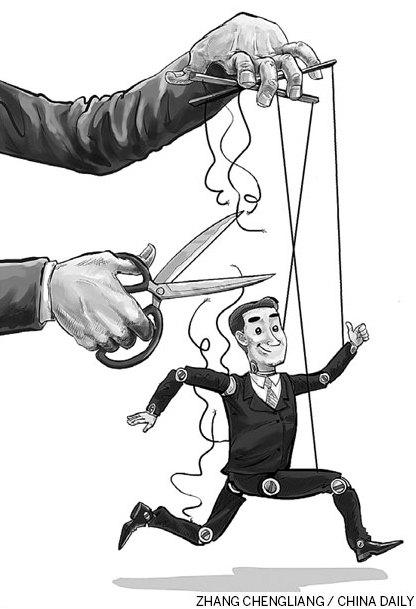
Likonomics is healthy dose of prudent monetary, fiscal policies focused on reforms
Likonomics 101 shows Premier Li Keqiang's grasp of the technical complexities of the political economy of reform and the daunting tasks of pushing through reforms at a time of profound transformation domestically and internationally.

First, he put jobs at the core of his thinking, recognizing that every one percentage point GDP growth can create 1.3 to 1.5 million jobs. To generate enough jobs for 10 million new labor entrants and keep urban unemployment around 4 percent, China needs annual growth of about 7.2 percent.
This year alone, there are 7 million graduates coming into the job market. In the first three quarters of this year, 10 million jobs were created, keeping the unemployment level on target.
Second, he laid out his choices to keep growth - either use monetary and fiscal policies, or go for structural reforms. He was pragmatic. With M2 money supply already at twice GDP and keeping the fiscal deficit below 3 percent of GDP, his choice is to stick to current monetary policy of appropriate tightness and fiscal deficit of about 2.1 percent of GDP.
This meant that he is opting for the third arrow of structural reforms. In classic Chinese directness, he went straight for the core issue of the relationship between State and market, but illustrated this with an example of how a Beijing student returning to his county had to get dozens of approvals and wait months before he could open a bookshop. In the last six months, his government has reduced 221 administrative approval procedures and, in the Shanghai free trade zone, has introduced for the first time a negative list. Historically, Chinese officialdom has required approval for everything.
In Li's words, the government should let go what the market can do and regulate what should be regulated.
To get the market going, especially SMEs, tax exemption has been given on VAT and income tax on SMEs earning below 20,000 yuan ($3,282) a year.
To demonstrate that the government is serious about moving toward the market, the decision has been taken to corporatize the huge railways sector, which employs more than 2 million people and runs only 100,000 km of rail, compared with 250,000 km of rail in the US.
Deregulation is a necessary condition for growth but, by itself, is insufficient. The premier laid out where he saw breakthrough areas. China will soon grant 4G mobile licenses. Last year, Chinese online e-commerce reached 1.3 trillion yuan, a level already reached in the first three quarters of this year. It may overtake US e-commerce in size by next year. He has identified retirement and healthcare as key drivers of the service economy, noting that the Chinese service sector is at least 10 percent of GDP and smaller than other comparable economies.
In order to address the housing needs of the poor, China will renovate low-income housing, which houses 40 million people, of which 70 percent are retirees. Under the 12th Five-Year Plan (2011-15), the country will build 36 million public housing units.
Another breakthrough is the opening-up strategy. Li laid out that in the context of building domestic consumption. Noting that the export sector creates jobs for 30 million people directly and for 100 million indirectly, it would be unrealistic to switch completely out of exports into domestic consumption. Thus, China has become strongly pro-multilateralism and against protectionism. In other words, China will welcome inward FDI participation in its home market just as it will continue to promote outward trade and investments.
Li has also incorporated "forward guidance" in his economic management toolbox. He will maintain annual growth expectations at around 7.5 percent, with CPI around 3.5 percent. He felt that the target is realistic, because during the first three quarters of this year, industrial use of electricity rose 9.8 percent year-on-year and railway cargo grew 7.3 percent year-on-year. Moreover, he expressed confidence that the GDP growth numbers can be achieved, because there is a huge gap in growth rates between the coastal areas, which are moving into higher middle-income brackets, and the central and western regions of China, where the per capita income level is still half that of the national average.
Top among his concerns is the social security safety net. There are 20 million urban poor and another 5 million rural poor, who have to be looked after. Currently 300 million urban workers are members of social security schemes, but this year, there were 38 million who stopped their social security contributions, because migrant workers stopped paying after 15 years of contributions. Every year, there are 3 million workers who suffer from serious illness. Hence, social security and pension reform and healthcare reform will receive top priority.
Finally, the premier addressed the question of labor income. He reiterated that wage increases must move in step with labor productivity. The 12th Five-Year Plan had recommended the doubling of nominal wages in five years. This year, the minimum wage increase for 24 top provinces/cities was 18 percent. This is putting pressure on China's export competitiveness. At the same time, Li also recognized that the 260 million rural or agricultural labor force has a productivity and wage level problem. Overall, he understood that continuous education and skills training lie at the heart of changing labor productivity.
In sum, Likonomics comprised a healthy dose of prudent monetary and fiscal policy, with a clear eye on pragmatic structural reforms, which will require cutting back government over-regulation and allowing market forces to work.
Keynesian economics assumes the markets will work as long as the macro is right while neoclassical economics assumes the macro will work so long as the micro is right. Likonomics tackles micro, macro and structural problems simultaneously. That is no easy feat.
Somehow, I think John Maynard Keynes and Joseph Schumpeter would have approved of these reform objectives.
The author is president of the Fung Global Institute, a Hong Kong-based research institution. The views do not necessarily reflect those of China Daily.








